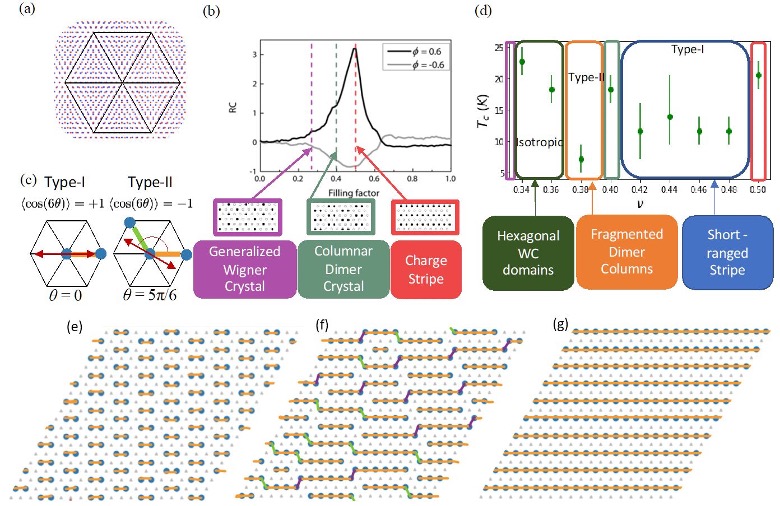PARADIM Highlight #68—In-House Research (2023)
Eun-Ah Kim (Cornell University)
Moiré superlattice systems such as transition metal dichalcogenide heterobilayers have garnered significant recent interest due to their promising utility as tunable solid-state simulators. Recent experiments on a WSe2/WS2 heterobilayer detected charge ordered states at commensurate fillings (electron counts).

Figure 1: a-d) TMD Moiré system, crystalline (b), two types of nematic (c) and the intermediate phases (d). e-g) Electronic liquid crystalline phase (f) in between two electronic crystal phases (e and g).
Members of PARADIM’s in-house research team have used Monte Carlo simulations to study intermediate phases occurring at fractional electron counts between the charge-ordered states in the strong coupling limit. The team found two distinct stripe solid states to be each preceded by distinct types of nematic states and describes a microscopic mechanism that stabilizes each of the nematic states.
The results provide a testable experimental electronic phase diagram of Moiré materials, including predictions of where both types of nematic order occur and elucidate the microscopic mechanism driving their formation.
Moiré superlattice systems such as transition metal dichalcogenide heterobilayers have garnered significant recent interest due to their promising utility as tunable solid state simulators. Recent experiments on a WSe2/WS2 heterobilayer detected charge ordered states at commensurate fillings (electron counts). In this work, an experimentally testable electronic phase diagram for heterobilayer dichalcogenides is predicted. Here we use Monte Carlo simulations to study these intermediate phases in between charge-ordered states in the strong coupling limit. We find two distinct stripe solid states to be each preceded by distinct types of nematic states. In particular, we discover microscopic mechanisms that stabilize each of the nematic states, whose order parameter transforms as the two-dimensional E representation of the Moiré lattice point group. Our results provide a testable experimental prediction of where both types of nematic occur and elucidate the microscopic mechanism driving their formation.
The simulation results provide timely guidance on rapidly growing field of the study of generalized Wigner crystals. It is also an example of testable theoretical predictions of electronic phase diagrams.
Close communication with the experimental groups of Jie Shan and K-F Mak helped us identify an important problem and opportunity in a timely manner.
The work was performed by members of PARADIM’s in-house research team.
The work has been featured in the Cornell Chronicle: https://news.cornell.edu/stories/2022/11/physicist-identifies-how-electron-crystals-melt.
M. Matty and E.-A. Kim, "Melting of Generalized Wigner Crystals in Transition Metal Dichalcogenide Heterobilayer Moiré Systems," Nature Communications 13, 7098 (2022).
The authors acknowledge support by the NSF [Platform for the Accelerated Realization, Analysis, and Discovery of Interface Materials (PARADIM)] under cooperative agreement no. DMR-1539918. We would also like to thank Steven Kivelson, Kin-Fai Mak, Jie Shan, Sue Coppersmith, Ataç Imamoğlu, and Samuel Lederer for helpful discussions.
Monte Carlo data and software codes associated with this work are available at the following DOIs: 10.5281/zenodo.7120826 (data) and 10.5281/zenodo.7120887 (codes).







